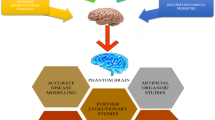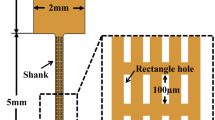Abstract
The long-term reliability of the neural electrode is closely related to its implantation behavior. In order to realize the quantitative research of the implantation behavior in a low-cost and accurate way, a refined brain model containing meninges is proposed. First, the expected simulation material was selected through measuring the elastic modulus based on the method of atomic force microscope indentation technique. As a result, the 2% (mass fraction) agarose gel simulated the gray and white matter, the 7 : 1 (volume ratio) polydimethylsiloxane (PDMS) sheet simulated the pia mater, and the polyvinyl chloride (PVC) film simulated the dura mater. Second, based on designing a three-layer structure mold, the brain model was prepared by inverted pouring to realize a flat implantation surface. Finally, the simulation behavior of the brain model was investigated with the rat brain as a reference. For mechanical behavior of implantation, the implantation force experienced two peaks both in the brain model and the rat brain, maximum values of which were 10.17mN and 7.69mN respectively. The larger implantation force in the brain model will increase the strength requirement for the electrode, but reduce the risk of buckling of that in practical application. For humoral dissolution behavior, the dissolution rates of the polyethylene glycol (PEG) coating of the electrode in the brain model and rat brain were 7 000 μm3/s and 5 600 μm3/s, respectively. The faster dissolution rate in the brain model will cause the larger thickness of the coating design but provide sufficient implantable time in practical application. The establishment of the brain model and the research of its simulated behavior are beneficial to the size design of the electrode substrate and coating, and research of the implantation mechanism, and further increase the functional life of the electrode.
摘要
神经电极的长期可靠性与其植入行为密切相关. 为了以低成本和精确的方式实现神经电极植入行为的定量研究, 设计了一种包含脑膜的精细脑模型. 首先, 基于原子力显微镜压痕技术, 通过测量弹性模量选择符合预期的脑模型模拟材料. 结果表明, 2%琼脂糖凝胶用于模拟灰质和白质, 7:1聚二甲基硅氧烷薄片用于模拟硬脑膜, 聚氯乙烯薄膜用于模拟硬脑膜. 其次, 设计了具有三层结构的脑模型模具, 采用倒浇法制备脑模型, 可以获得较为平整的植入表面; 最后以大鼠脑为参照, 对脑模型的模拟行为进行了研究. 在植入力学行为上, 植入力曲线在脑模型和大鼠脑中均出现两个峰值, 其中较大峰值分别为10.17 mN和7.69 mN. 脑模型中植入力更大, 代表脑模型对电极的强度要求就越大, 但该特点在实际应用中降低了电极植入屈曲的风险. 对于体液溶解行为, 电极的PEG涂层在脑模型和大鼠脑中的溶解速率分别为7000 μm3/s和5600 μm3/s. 脑模型中更快的溶解速度会导致涂层设计的厚度更大, 但在实际应用中提供更充足的植入时间. 脑模型的建立及其模拟行为的研究有利于电极基底和涂层的尺寸设计、 植入机理的研究, 进一步提高电极的功能性寿命.
Similar content being viewed by others
References
BOEHLER C, CARLI S, FADIGA L, et al. Tutorial: Guidelines for standardized performance tests for electrodes intended for neural interfaces and bioelectronics [J]. Nature Protocols, 2020, 15(11): 3557–3578.
HONG G S, LIEBER C M. Novel electrode technologies for neural recordings [J]. Nature Reviews Neuroscience, 2019, 20(6): 330–345.
KOZAI T D Y, JAQUINS-GERSTL A S, VAZQUEZ A L, et al. Brain tissue responses to neural implants impact signal sensitivity and intervention strategies [J]. ACS Chemical Neuroscience, 2015, 6(1): 48–67.
ZHANG W G, MA Y K, LI Z W. Experimental evaluation of neural probe’s insertion induced injury based on digital image correlation method [J]. Medical Physics, 2016, 43(1): 505–512.
YIN X L, ZHANG W G, TANG J Q, et al. Micromotion simulation and optimal design of multi-shank fishbone-shaped electrode [J]. Journal of Shanghai Jiao Tong University, 2019, 53(5): 529–534(in Chinese).
NA K, SPERRY Z J, LU J A, et al. Novel diamond shuttle to deliver flexible neural probe with reduced tissue compression [J]. Microsystems & Nanoengineering, 2020, 6: 37.
WEN X M, WANG B, HUANG S, et al. Flexible, multifunctional neural probe with liquid metal enabled, ultra-large tunable stiffness for deep-brain chemical sensing and agent delivery [J]. Biosensors and Bioelectronics, 2019, 131: 37–45.
LECOMTE A, DESCAMPS E, BERGAUD C. A review on mechanical considerations for chronically-implanted neural probes [J]. Journal of Neural Engineering, 2018, 15(3): 031001.
AIMEDIEU P, GREBE R. Tensile strength of cranial pia mater: Preliminary results [J]. Journal of Neurosurgery, 2004, 100(1): 111–114.
JOO H R, FAN J L, CHEN S P, et al. A micro-fabricated, 3D-sharpened silicon shuttle for insertion of flexible electrode arrays through dura mater into brain [J]. Journal of Neural Engineering, 2019, 16(6): 066021.
ZHANG W G, ZHOU X H, HE Y X, et al. Implanting mechanics of PEG/DEX coated flexible neural probe: Impacts of fabricating methods [J]. Biomedical Microdevices, 2021, 23(1): 17.
ZHOU X H, ZHANG W G, XIE J. Effects of micro-milling and laser engraving on processing quality and implantation mechanics of PEG-dexamethasone coated neural probe [J]. Journal of Shanghai Jiao Tong University (Science), 2021, 26(1): 1–9.
WALSH D R, ZHOU Z, LI X G, et al. Mechanical properties of the cranial meninges: A systematic review [J]. Journal of Neurotrauma, 2021, 38(13): 1748–1761.
ZHAO Z T, LI X, HE F, et al. Parallel, minimally-invasive implantation of ultra-flexible neural electrode arrays [J]. Journal of Neural Engineering, 2019, 16(3): 035001.
CHEN P C, CLARK C, SHEN C P J, et al. Ultrasonically actuated inserted neural probes for increased recording reliability [C]//2013 Transducers & Eurosensors XXVII: The 17th International Conference on Solid-State Sensors, Actuators and Microsystems. Barcelona: IEEE, 2013: 872–875.
MESA-MÚNERA E, RAMÍREZ-SALAZAR J F, BOULANGER P, et al. Inverse-FEM characterization of a brain tissue phantom to simulate compression and indentation [J]. Ingenieríay Ciencia, 2012, 8(16): 11–36.
RUNZA M, PIETRABISSA R, MANTERO S, et al. Lumbar dura mater biomechanics: Experimental characterization and scanning electron microscopy observations [J]. Anesthesia and Analgesia, 1999, 88(6): 1317–1321.
CASTAGNOLA V. Implantable microelectrodes on soft substrate with nanostructured active surface for stimulation and recording of brain activities [D]. Toulouse: Universite Toulouse III Paul Sabatier, 2014.
CHEN X, ZENG Z, ZHANG H, et al. Study on methods of obtain elastic modulus of rabbit keratocytes by force volume model of AFM [J]. Beijing Biomedical Engineering, 2020, 39(6): 574–581 (in Chinese).
NOMOEV A V, LYGDENOV V T, KHARTAEVA E C, et al. Measurement of the Young’s modulus of composite polymer coatings using atomic force microscopy [J]. AIP Conference Proceedings, 2020, 2288(1): 030092.
MCCRACKEN P J, MANDUCA A, FELMLEE J, et al. Mechanical transient-based magnetic resonance elastography [J]. Magnetic Resonance in Medicine, 2005, 53(3): 628–639.
HE Y X, ZHANG W G, XU L Y, et al. Implantation strategies of invasive flexible neural electrode [J]. Journal of Medical Biomechanics, 2021, 36(1): 151–157 (in Chinese).
WANG X C, HIRSCHBERG A W, XU H J, et al. A parylene neural probe array for multi-region deep brain recordings [J]. Journal of Microelectromechanical Systems, 2020, 29(4): 499–513.
SHI B, HAO X, LUO D, et al. Effect of erythrocyte on brain water content and expression of HO-1 in rat with traumatic intracerebral hemorrhage [J]. Chinese Journal of Nervous and Mental Diseases, 2007, 33(11): 666–668 (in Chinese).
Acknowledgment
The authors thank the Instrumental Analysis Center of Shanghai Jiao Tong University for the elastic modulus measuring on AFM, and the Laboratory Animal Center of Shanghai Jiao Tong University for the help of experiments involving rat brain.
Author information
Authors and Affiliations
Corresponding author
Additional information
Foundation item: the National Natural Science Foundation of China (No. 51675330)
Rights and permissions
About this article
Cite this article
He, Y., Zhang, W., Xu, H. et al. Establishment of a Refined Brain Model for Evaluating Implantation Behavior of Neural Electrode and Research of its Simulated behavior. J. Shanghai Jiaotong Univ. (Sci.) 28, 401–410 (2023). https://doi.org/10.1007/s12204-022-2523-5
Received:
Accepted:
Published:
Issue Date:
DOI: https://doi.org/10.1007/s12204-022-2523-5




